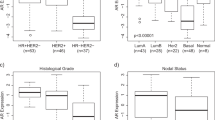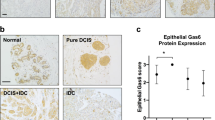Abstract
The expression of three epidermal growth factor (EGF)-related peptides, transforming growth factor alpha (TGF-alpha), amphiregulin (AR) and cripto-1 (CR-1), was examined by immunocytochemistry (ICC) in 68 primary infiltrating ductal (IDCs) and infiltrating lobular breast carcinomas (ILCs), and in 23 adjacent non-involved human mammary tissue samples. Within the 68 IDC and ILC specimens, 54 (79%) expressed immunoreactive TGF-alpha, 52 (77%) expressed AR and 56 (82%) expressed CR-1. Cytoplasmic staining was observed with all of the antibodies, and this staining could be eliminated by preabsorption of the antibodies with the appropriate peptide immunogen. Cytoplasmic staining with all of the antibodies was confined to the carcinoma cells, since no specific immunoreactivity could be detected in the surrounding stromal or endothelial cells. In addition to cytoplasmic reactivity, the AR antibody also exhibited nuclear staining in a number of the carcinoma specimens. No significant correlations were found between the percentage of carcinoma cells that were positive for TGF-alpha, AR or CR-1 and oestrogen receptor status, axillary lymph node involvement, histological grade, tumour size, proliferative index, loss of heterozygosity on chromosome 17p or overall patient survival. However, a highly significant inverse correlation was observed between the average percentage of carcinoma cells that expressed AR in individual tumours and the presence of a point-mutated p53 gene. Likewise, a significantly higher percentage of tumour cells in the ILC group expressed AR as compared with the average percentage of tumour cells that expressed AR in the IDC group. Of the 23 adjacent, non-involved breast tissue samples, CR-1 could be detected by ICC in only three (13%), while TGF-alpha was found in six (26%) and AR in ten (43%) of the non-involved breast tissues. These data demonstrate that breast carcinomas express multiple EGF-related peptides and show that the differential expression of CR-1 in malignant breast epithelial cells may serve as a potential tumour marker for breast cancer.
This is a preview of subscription content, access via your institution
Access options
Subscribe to this journal
Receive 24 print issues and online access
$259.00 per year
only $10.79 per issue
Buy this article
- Purchase on Springer Link
- Instant access to full article PDF
Prices may be subject to local taxes which are calculated during checkout
Similar content being viewed by others
Author information
Authors and Affiliations
Rights and permissions
About this article
Cite this article
Qi, CF., Liscia, D., Normanno, N. et al. Expression of transforming growth factor α, amphiregulin and cripto-1 in human breast carcinomas. Br J Cancer 69, 903–910 (1994). https://doi.org/10.1038/bjc.1994.174
Issue Date:
DOI: https://doi.org/10.1038/bjc.1994.174
This article is cited by
-
An Updated Review on Recent Advances in the Usage of Novel Therapeutic Peptides for Breast Cancer Treatment
International Journal of Peptide Research and Therapeutics (2023)
-
Lack of transforming growth factor-β signaling promotes collective cancer cell invasion through tumor-stromal crosstalk
Breast Cancer Research (2012)
-
Prolyl-4-hydroxylase PHD2- and hypoxia-inducible factor 2-dependent regulation of amphiregulin contributes to breast tumorigenesis
Oncogene (2011)
-
Amphiregulin as a Novel Target for Breast Cancer Therapy
Journal of Mammary Gland Biology and Neoplasia (2008)
-
Inhibition of epidermal growth factor receptor signalling reduces hypercalcaemia induced by human lung squamous-cell carcinoma in athymic mice
British Journal of Cancer (2007)



